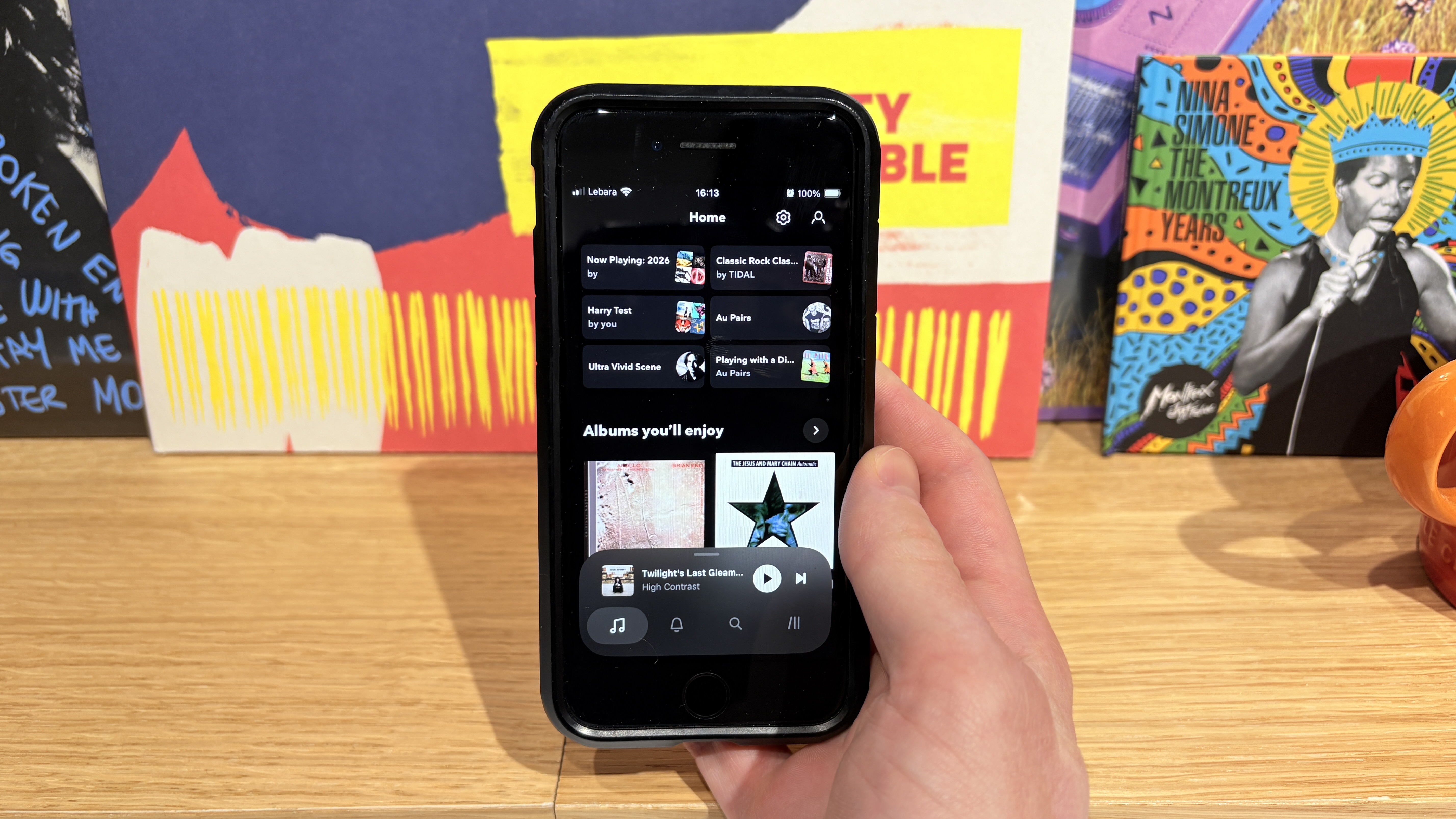Apple Music vs Spotify: which is better?
The two giants of music streaming each offer compelling experiences, but which service deserves your monthly outlay?
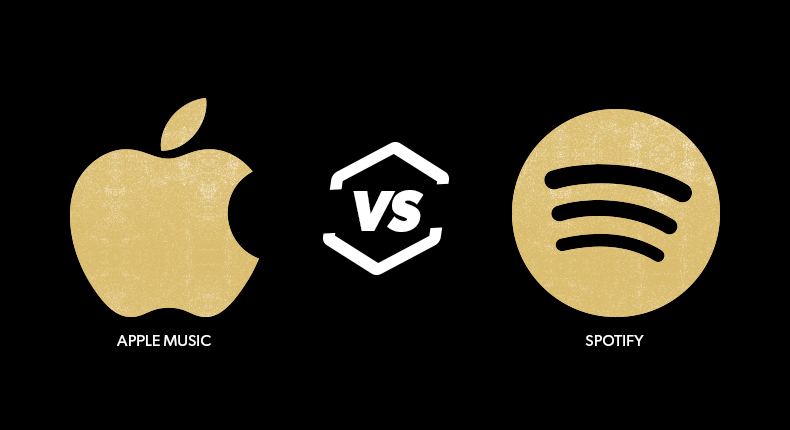
Music streaming now accounts for 69 per cent of global music revenues: $19 billion in revenue annually, according to IFPI's Global Music Report 2025. Spotify and Apple Music are two of the biggest services around – the former dominates, with a 31 per cent market share, while Apple Music has a still very respectable 15 per cent.
Considering Spotify had almost a 10-year head start (launching in 2006 to Apple Music's 2015), Apple has made up significant ground.
But which of these is right for you?
To help you decide, we'll run you through what they offer, which devices they're compatible with, how much they cost, and – crucially – which one sounds best.
Let's get listening.
The state of play
Music streaming continues to grow in popularity, which means plenty of services to choose from. They all have slightly different offerings, with different music libraries and features, and most offer CD-quality and/or hi-res streaming.
Tidal and Qobuz were the pioneers in this regard, but now it's pretty common, with even the likes of Amazon Music Unlimited offering it.
The latest hi-fi, home cinema and tech news, reviews, buying advice and deals, direct to your inbox.
Apple Music set the industry standard in 2021 when it offered hi-res tracks at no additional fee. Which prompted rivals to drop their prices and match the offer. Spotify's Lossless tier was rumoured to cost around £5 / $5 more per month, but when it finally arrived in September 2025, it was included in the standard Spotify Premium tier.
It was a crumb of comfort for Spotify users who had endured an agonising eight-year wait for hi-res to arrive.
Of course, there's a lot more to a streaming service than just hi-res. As we'll see, both Spotify and Apple Music have plenty to recommend them.
Subscription plans
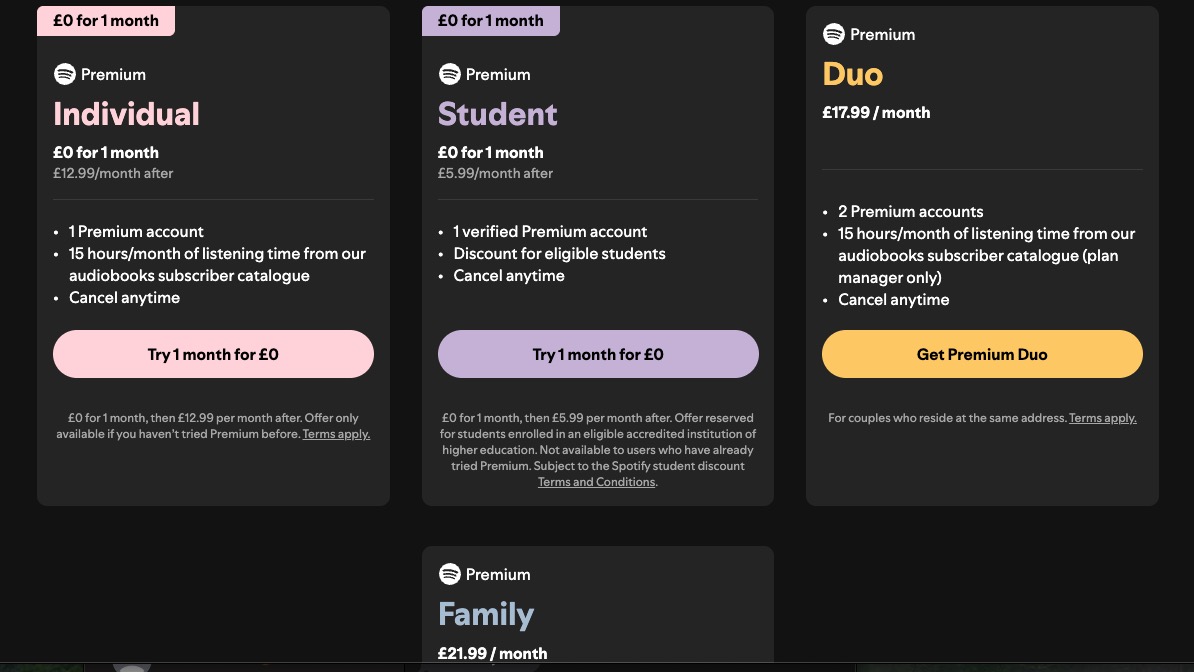
- Spotify has a free tier (with limitations)
- Spotify Premium costs £12.99 / $11.99 / AU$15.99 per month (as of 2025)
- Apple Music monthly subscription is £10.99 / $10.99 / AU$12.99
If you don’t have the extra cash to splash on streaming, then Spotify should probably be your go-to service.
Staying true to its “music for everyone” ethos, it is one of the few to offer a free (ad-supported) subscription tier alongside its Premium service.
It's still pretty basic, but it's better than it used to be. Alongside the Lossless launch in September 2025 for Premium users, Spotify upgraded the free tier with more playback options. You can now search for and play specific tracks, play any song you find while browsing (what Spotify calls Pick & Play) and play any song that's shared with you by a friend or artist.
Other new features include the ability to create your own playlists (with your own custom artwork), and listen to podcasts.
Previously, free users could only shuffle tracks based on a chosen one, or listen to predetermined playlists.
But the sound quality is still pretty poor. The free tier offers only 128kbps on the web player and approximately 160kbps on its desktop and mobile apps. Plus it lacks downloads for offline listening.
It does offer access to most of Spotify’s premium library, though, including the 'Discover Weekly' playlist, which is one of the real jewels of Spotify's music discovery algorithms.
Of course, you'll have to put up with those annoying adverts interrupting your listening. To get rid of them, you'll have to cough up.
The majority of Spotify users settle for the free tier, but there are plenty of reason to shell out for Premium: Lossless listening at better-than-CD quality (24-bit/44.1kHz) across most of its vast catalogue, offline listening, Spotify Connect support and no adverts.
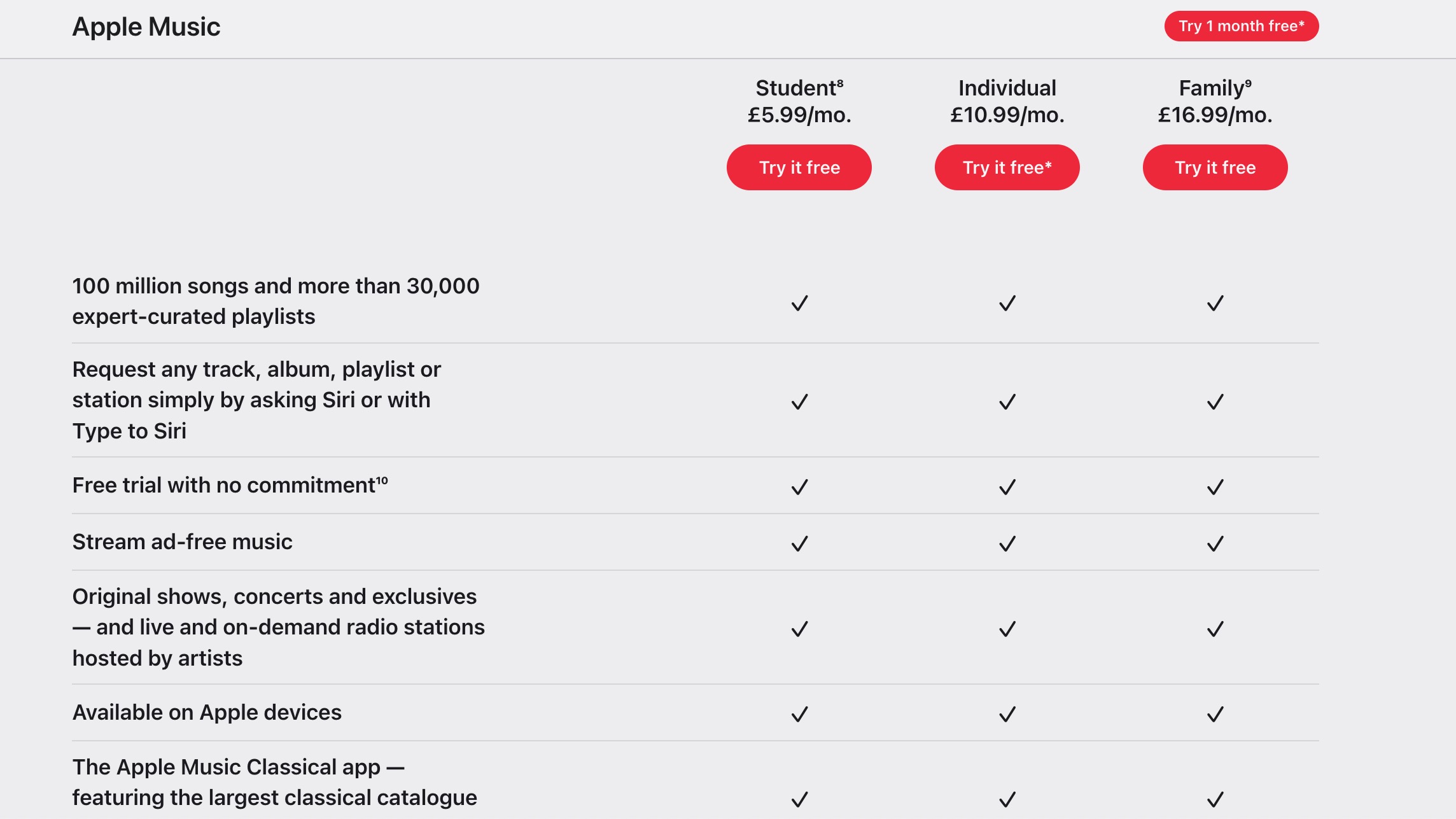
Apple Music doesn’t have a free tier, although there is a three-month free trial if you buy certain Apple devices or plans like iCloud+. You also don't need a subscription to listen to Apple Music 1 radio (formerly Beats 1) – one of the service’s most celebrated features. All you need is an Apple ID and the Apple Music app.
For online and offline streaming and access to more radio stations, the monthly fee is £10.99 / $10.99 / AU$12.99. Students can get it for £5.99 / $5.99 / AU$6.99, and families (with up to six people accessing it) for £16.99 / $16.99 / AU$19.99.
Spotify has had frequent price increases, and its Individual and Family tiers are now more expensive than Apple's: £12.99 / $11.99 / AU$15.99 and £21.99 / $19.99 / AU$27.99, respectively. Spotify too has a Student plan, and it also has a Duo tier for couples, which costs £17.99 / $16.99 / AU$22.99 a month.
Apple's prices have only edged up a fraction since launch, whereas Spotify's have crept ever higher in recent years. This round is Apple's.
**Winner: Apple Music**
Catalogues
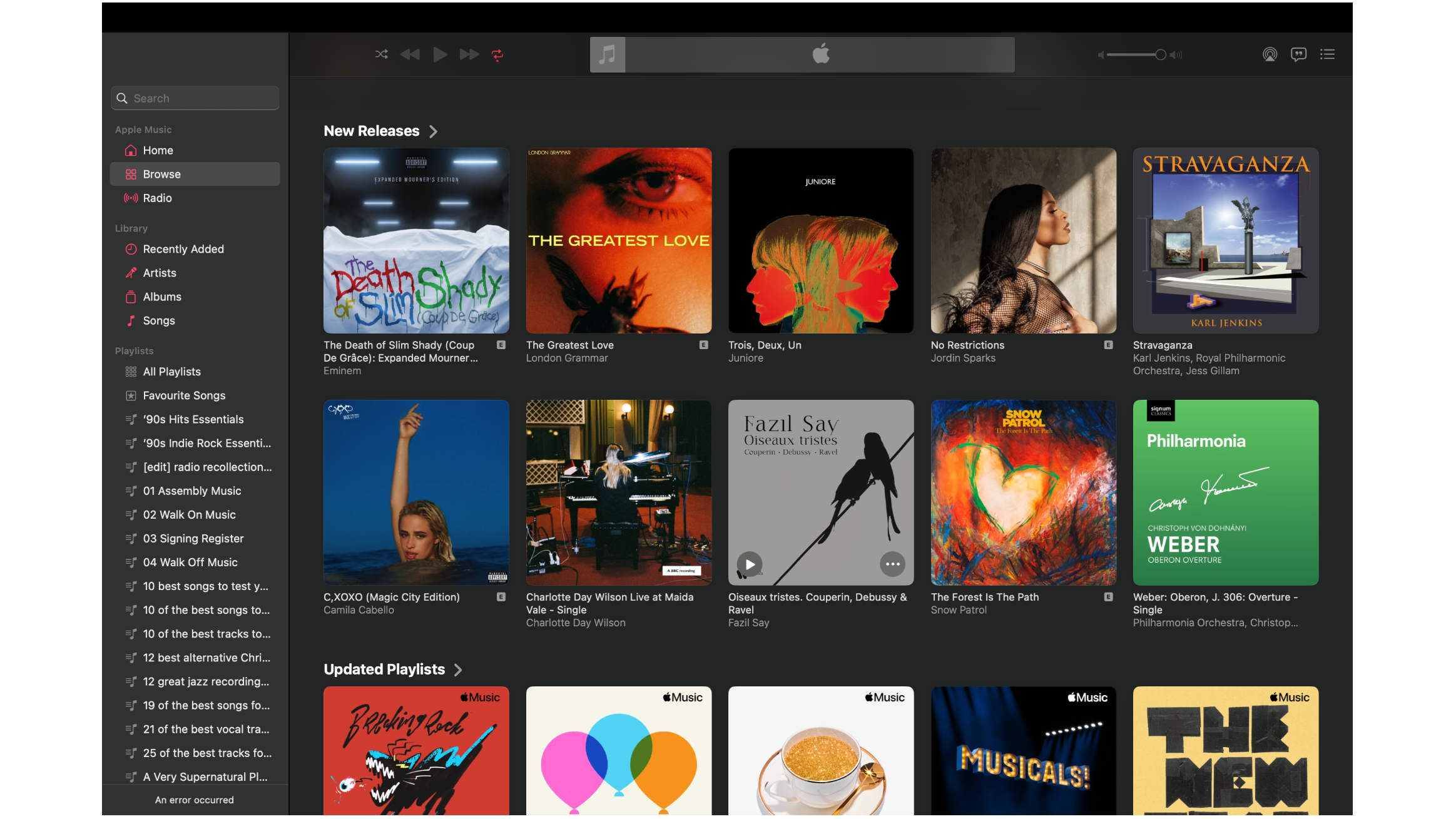
- Both claim 100+ million tracks
- Spotify includes podcasts and audiobooks
- Apple Music has human-curated radio stations, plus Apple Musical Classical offshoot
- Spotify Connect integrated in wider range of audio/hi-fi products
It’s a pretty even match when it comes to catalogue size and platform support.
Both Apple Music and Spotify claim to have over 100 million tracks in their catalogues. The latter has a wider variety of audio content, also offering over 7 million podcasts and a growing audiobooks section, too.
Apple Music doesn't host podcasts – they're in Apple's separate Podcasts app. Audiobooks can be found in iOS's separate Books app, too, and cost extra. One bonus is that Apple Music Classical – a separate app dedicated to classical music only and different search/layout – is thrown in as part of your monthly subscription at no extra cost.
Perhaps Apple's advantage over Spotify here is that while both services offer playlists that comprise songs based on your listening habits, Apple also has the Apple Music 1 radio station, which features human DJs at the decks.
Fronted by DJs such as Zane Lowe and featuring a host of celebrity guest slots (from the likes of Dr Dre, Pharrell Williams and Elton John), Apple Music 1 is something that no other streaming service has – and ultimately one Spotify has to take on the chin.
Both services are available on a number of platforms: there’s desktop support for PC and Mac (Spotify has a web player too), plus Android and iOS apps.
Spotify also has the benefit of its Spotify Connect feature, which lets premium subscribers stream directly to speakers, TVs or systems, while Apple deploys AirPlay 2 here.
Both have become a feature on many hi-fi and AV products – and it's a big pull for those interested in bringing streaming and multi-room listening to their existing system.
**Winner: Draw**
User experience
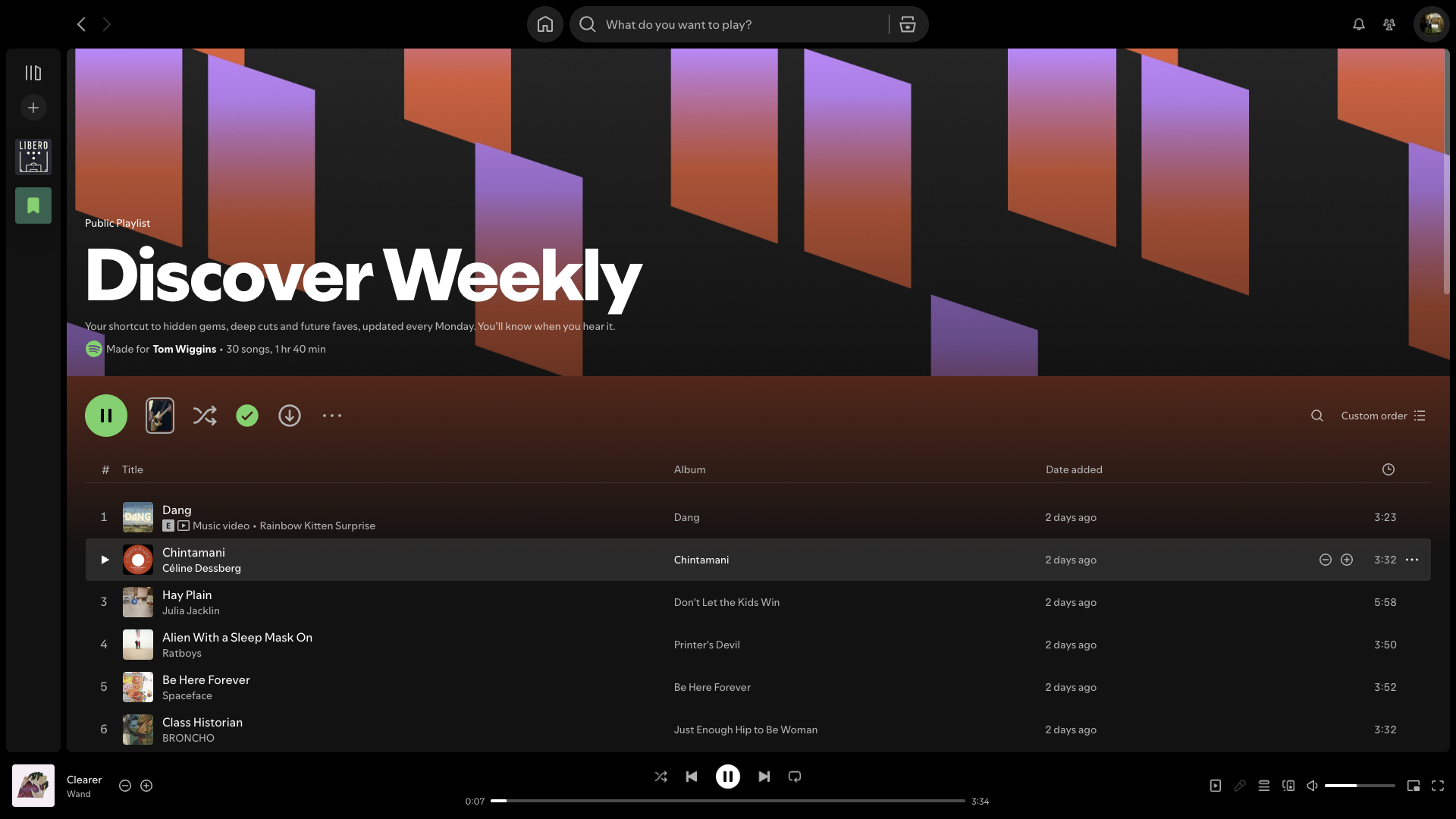
- Playlists, new music and more are sectioned into different tabs
- Desktop and mobile apps available
Both Spotify and Apple Music offer similarly clean, simple and intuitive layouts. That wasn’t always the case, though. When Apple Music first launched, we found its busy interface a bit clunky to use.
But with Apple's 2016 iOS 10 update, the Cupertino giant stripped it back, with cleaner typography and graphics. Features and options are hidden away behind icons and collapsible tabs, and the layout is easier to navigate.
The rule of thumb for using Apple Music is to click everything. Tapping the ellipsis that appears almost everywhere opens options such as: play next, add to library, add to a playlist, share (to any social media), lyrics and download.
Everything is neatly contained within five sections: Home, New, Radio, Library and Search.
Library is where all your music lives. This includes files stored on your smartphone, CD-ripped WAVs, your own playlists and any music you’ve saved and downloaded while streaming or listening to radio in Apple Music.
Thanks to its compatibility with iCloud, you’ll also be able to see all the music stored on your other devices.
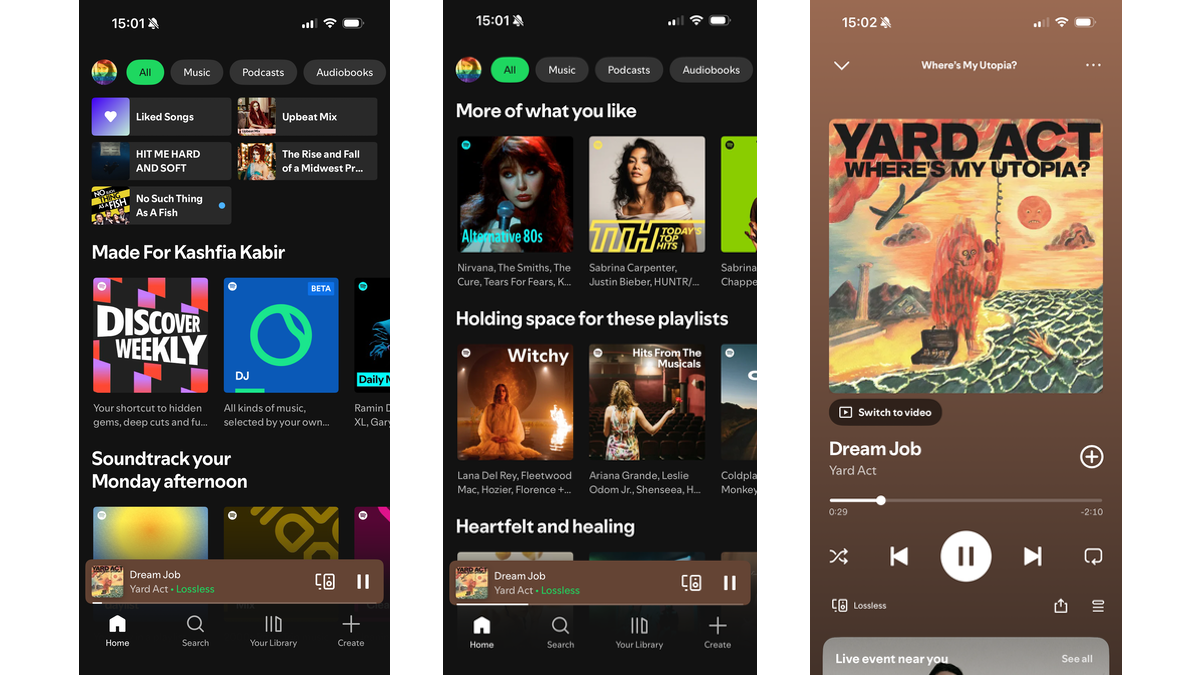
Spotify allows you to bring your local files into its interface too, but it’s not as well integrated. If you want all your music in one place, Apple Music does it better.
Spotify’s iconic green-tinted silver-on-grey interface has long been the ideal template with its logical and accessible sidebar menu layout, and its consistent focus on content over the years has made it all the more practical.
The Browse (or ‘home’) page throws up context-based playlists, constantly updated UK and global charts, and new releases for your attention, as well as content sorted by genre and based on tracks you’ve previously listened to.
A ‘Concert’ tab flags up gigs based on your music tastes and location, as well as ones that are popular near you. It's a nice addition for music lovers.
**Winner: Draw**
Discovery

- Both offer ample music recommendations according to genre and mood
- Both offer daily and weekly updated mixes based on listening
For those who like to explore new bands, both Spotify and Apple Music encourage the pioneer in you.
When you register for Apple Music, tapping on floating red circles highlighting different genres of music and artists gives an indication of your initial preferences.
Hitting ‘Love’ or ‘Dislike’ on songs updates this and we are certainly impressed by Apple’s curation, and by how on-point the playlists are. On the iOS app, there's a whole row of Top Picks For You, encompassing new releases, a New Music Mix, a Mood playlist for you and a Discovery Station, all based on what you've listened to.
By attributing a great deal of focus on music discovery through personalised algorithmic playlists, Spotify has managed to take this step too.
One of its most popular features is Discover Weekly, which uses Spotify’s ‘deep learning’ system to generate a playlist of 30 songs every Monday that are relevant to your listening habits.
There’s also more concentration on discovering new music. Complementing Discover Weekly is Release Radar, a playlist of brand-new music sent out every Friday, so that you never miss the latest tracks from your favourite artists.
It even includes new remixes of songs from artists you like or have recently listened to, and in case you need even more songs to soundtrack your weekend, there’s a New Music Friday UK playlist that ties in with the official UK chart. Rinsed them by Wednesday? That’s where the Daily Mix, which consists of five genre-specific playlists, comes in.
The more you listen, the more they evolve…
**Winner: Draw**
Sound quality
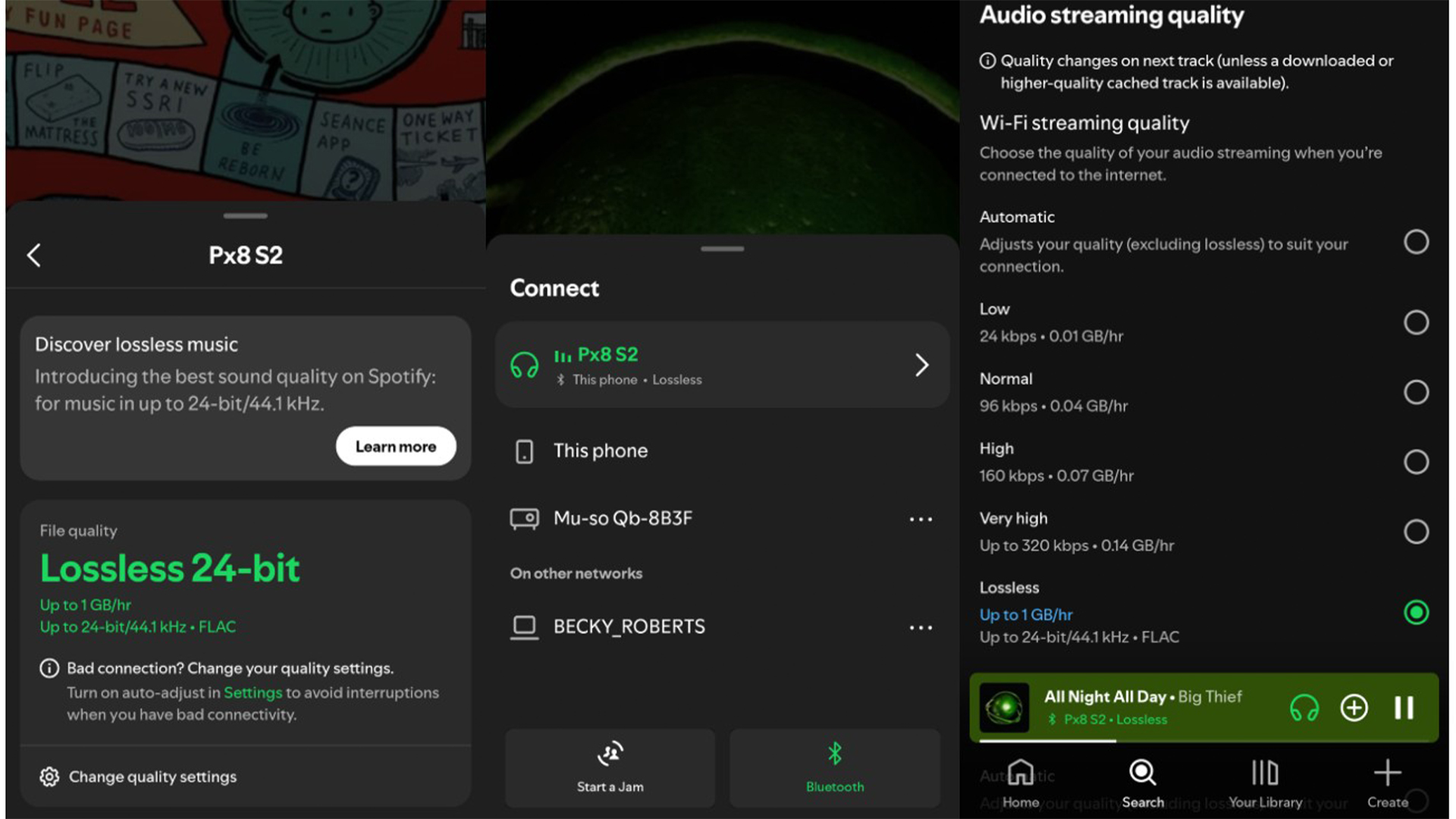
- Apple Music offers up to 24-bit/192kHz hi-res lossless listening
- All tracks are also available in Spatial Audio; Spotify doesn't support spatial or Dolby Atmos tracks
- Spotify Lossless offers up to 24-bit/44.1kHz hi-res quality (Premium subscribers only)
Apple Music has a big advantage here: higher-quality listening. And that's even despite Spotify launching its hi-res offering.
Apple Music offers tracks in 24-bit Lossless (24-bit/48kHz) and Hi-Res Lossless (up to 24-bit/192kHz). Both of which are a cut above Spotify Lossless, which tops out at 24-bit/44.1kHz. That's still better than CD quality, mind.
Listening to Michael Jackson's Thriller in Hi-Res Lossless, we can pick out even more detail than the equivalent stream on Tidal.
"As the vocal joins, extra musical guitar passages present themselves in our left ear – additions you’ll struggle to hear better when listening to the equivalent Tidal (Max quality) stream," we wrote in our review.
"The space around the instruments has expanded to the point that the door slam and each of Jackson’s numerous backing vocals have ample room to be impactful."
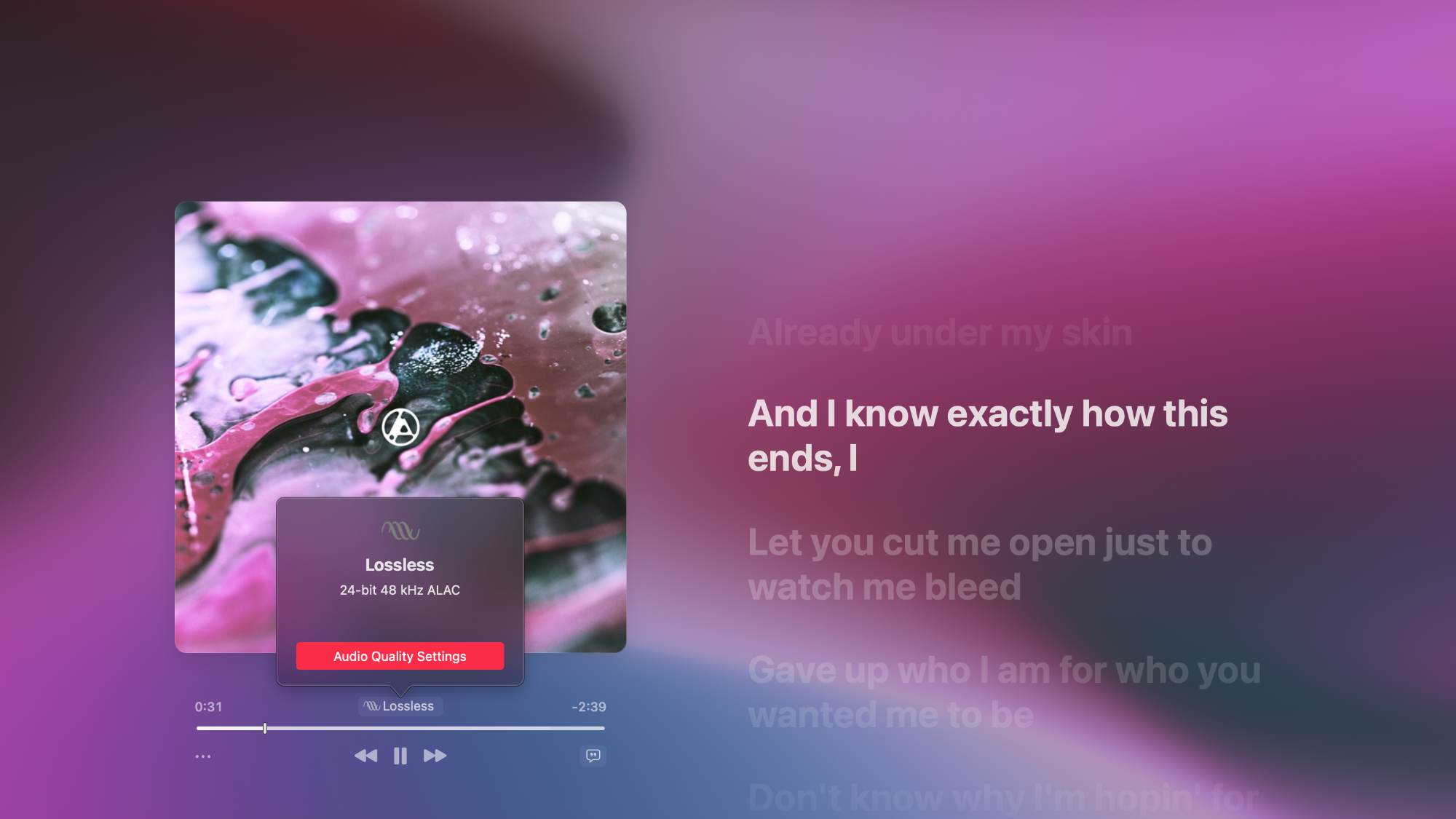
Even taking a step down in quality, Apple Music still wins out. Its 256kbps AAC files sound more open and involving than Spotify’s 320kbps MP3 streams, and benefit from extra space, subtlety and punch too.
Spotify Lossless is a real improvement on the service's standard 320kbps streams, though. They are "notably more involving," we noted in our review, being "clearer, punchier and more open and detailed, generally sounding less congested and messy than the 320kbps version."
Considering that Tidal's hi-res sound quality is far superior to Spotify's equivalent, Apple Music wins this round no contest. The difference will be even more pronounced if you're listening with kit that's transparent enough to really do your tracks justice – which the majority of Spotify's vast user base won't be, admittedly.
Spotify does have its awesome Connect feature though, which lets you stream straight from the internet to a device, bypassing your phone. Apple Music – or rather, Apple's AirPlay wireless technology – could really do with something similar.
For most people, Spotify's sound quality will be just fine, and they'll find Lossless a big step up from its previous standard. But for those of us who really care about sound quality, Apple Music is the clear winner.
**Winner: Apple Music**
Verdict
- Spotify's free tier and extensive features are appealing
- Apple Music is cheaper, offers true hi-res quality, and sounds better
Apple Music is cheaper (apart from Spotify's ad-supported tier, of course) and sounds much better. Which is enough to make it our clear winner here.
True, it lacks a comparable Connect feature, which it could really do with for enjoying the full resolution of its lossless library. Spotify's extensive features are undeniably appealing – especially for podcast and audiobook fans to listen in one place – and we very much welcome the new Lossless quality on offer.
But with a very similar catalogue size and broadly comparable discovery tools, plus the superior sound quality and better value proposition, Apple Music gets our vote.
**Overall winner: Apple Music**
MORE:
Apple Music lossless: which devices will (and won't) play lossless and Spatial Audio
Spotify Connect: what is it? Which devices support it?
Hi-res music streaming services compared: is Tidal, Qobuz, Spotify, Amazon or Apple Music better?
Joe has been writing about tech for 20 years, first on staff at T3 magazine, then in a freelance capacity for Stuff, The Sunday Times Travel Magazine (now defunct), Men's Health, GQ, The Mirror, Trusted Reviews, TechRadar and many more. His specialities include all things mobile, headphones and speakers that he can't justifying spending money on.
- Kashfia KabirHi-Fi and Audio Editor
You must confirm your public display name before commenting
Please logout and then login again, you will then be prompted to enter your display name.

